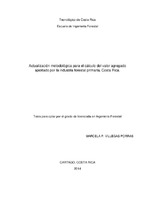Actualización metodológica para el cálculo del valor agregado aportado por la industria forestal primaria, Costa Rica.
Abstract
Primary processing industries are part of the primary sector and make the sawmilling process generating tables of different sizes with just little finish. The GDP allows to know the behavior of the national economy and the Central Bank of Costa Rica is calculated from the value added of products distributed in accounts, however forestry provided in the agricultural account and other, causing its contribution can´t be clearly appreciated. As a way to counter it in 2000 Mckenzie establishes the methodology used by the Oficina Nacional Forestal (ONF) for determining the value added and thus the real contribution to the sector. The aim of this study was to update the methodology for value added contributed by the primary industry so that suits today in Costa Rica. Of the 108 industries sampled by the ONF in early 2014 a random sub sample of 28 industries were selected and stratified according to its annual production in cubic meters and were surveyed about: productivity, employment, energy sources, machinery and equipment load; From this information to their cost structures and value added is determined. For indirect calculation of the areas of the structure three methods were tested: the first; equations proposed by McKenzie (2000), the second; trend lines generated graphics distribution and the third; average percentage rate. The methods were statistically compared using analysis of variance with hypothesis that there were no significant differences between them, once rejected the hypothesis test least significant difference (LSD) was applied. It was found that the best paying job is the manager, however small industries there is not manager, also 85% of machinery and equipment 75% load used are depreciated. The higher costs are: raw materials and variable costs, the latter include the employ’s salary. Primary industries are highly heterogeneous, making it difficult to determine a single method that meets the variety of cost structures. No significant differences between methods for variable costs and depreciation for fixed costs while no differences between strata or methods; taxes if difference between methods but the LSD test proved otherwise. For fixed costs and taxes equation with average most similar to the weighted average value was chosen. The equations proposed by McKenzie (2000) for variable costs and depreciation remain in force, fixed exchange costs have risen by 193% of depreciation and taxes 69.89% of employ’s salary. It is necessary to conduct a census of industries revalidate the proposed here from a larger sample.
Description
Proyecto de Graduación (Licenciatura en Ingeniería Forestal) Instituto Tecnológico de Costa Rica, Escuela de Ingeniería Forestal, 2014.


